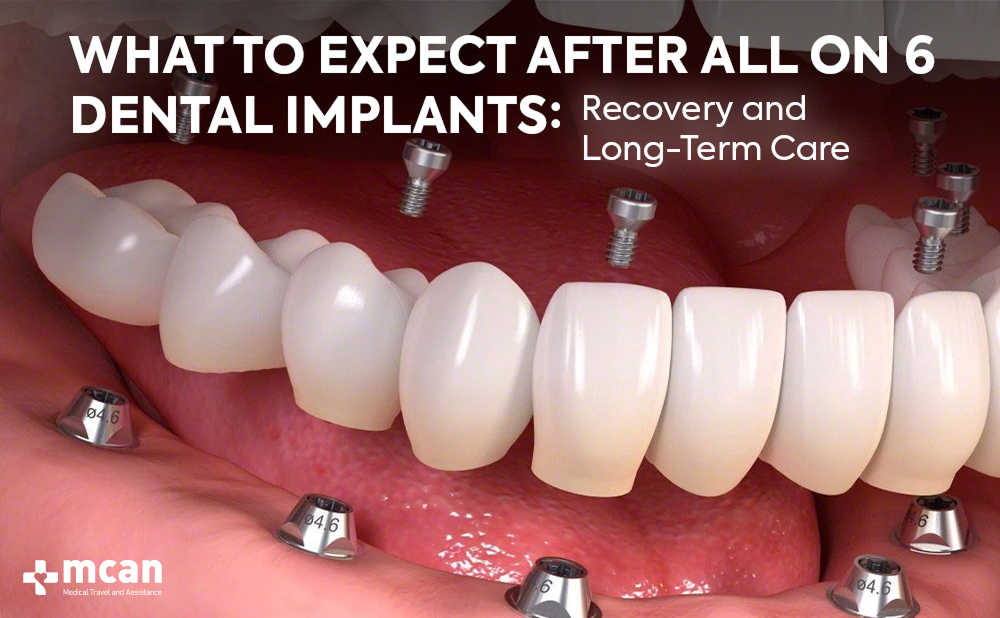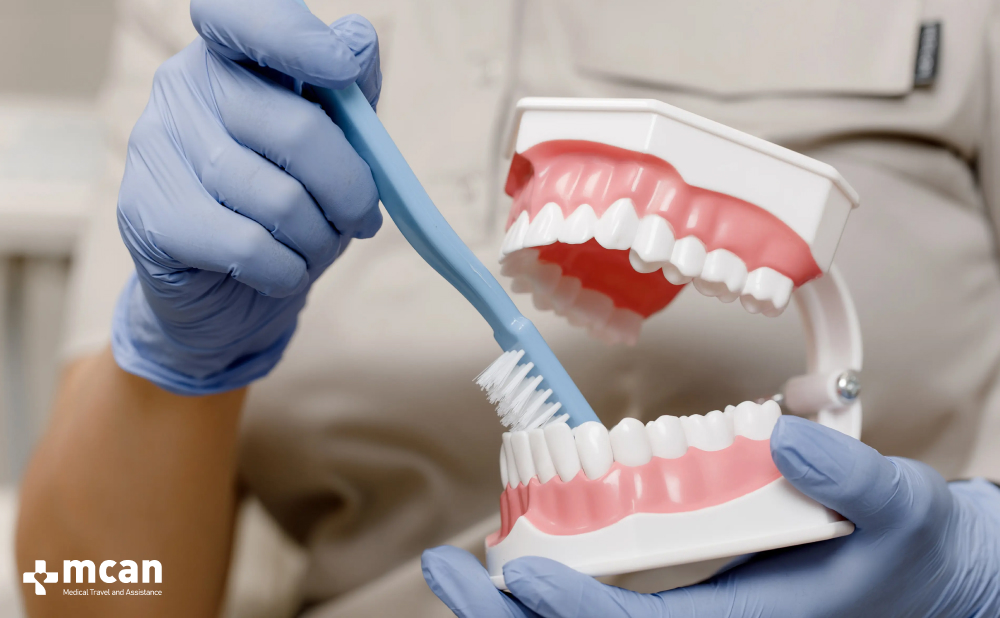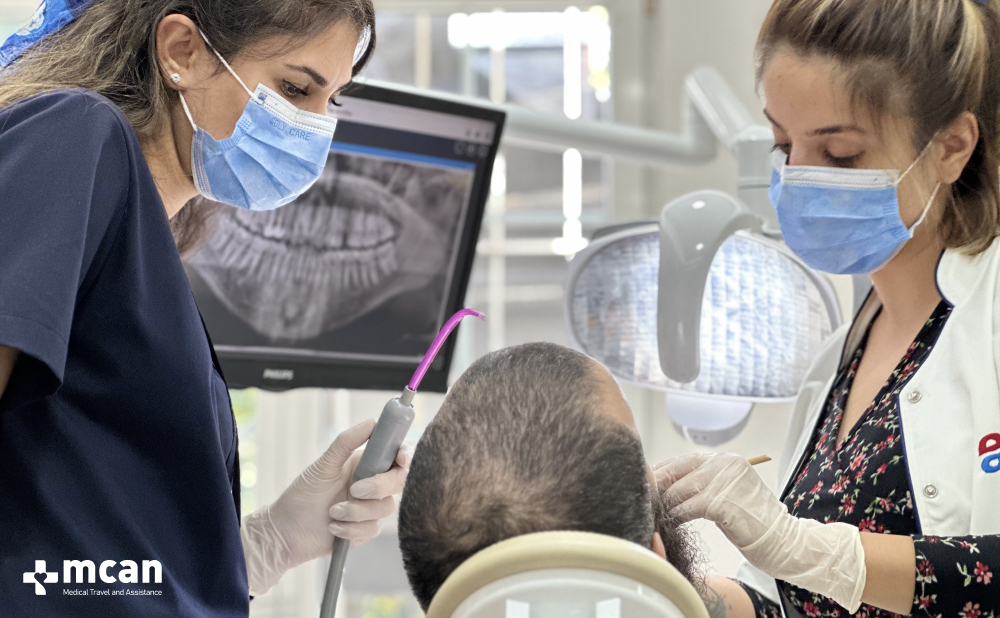
All on 6 dental implants are a reliable full-mouth restoration solution designed for patients who have lost most or all of their teeth. This method uses six strategically placed implants to anchor a fixed set of prosthetic teeth, offering both aesthetic and functional benefits. While the surgical procedure is precise and efficient, the recovery process that follows plays a crucial role in determining the long-term success of the treatment.
Recovery after All on 6 implants takes place in clearly defined stages, from the initial healing in the first few days to the long-term care that supports implant stability for years. Each phase comes with its own set of guidelines, milestones, and expectations that patients should understand and follow closely.
In this guide, we’ll walk through every step of the All on 6 dental implant recovery timeline, highlight what is normal during healing, offer insights into long-term maintenance, and explain how to protect your results for lasting function and comfort.
First 72 Hours of All on 6 Dental Implant Recovery
The first 72 hours after your All on 6 dental implant surgery mark the most delicate stage of healing. Your body will begin adjusting to the implants, and what you do during this period has a direct impact on your long-term results.
Swelling and bruising are expected and often reach their peak within the first 48 hours. This is part of the normal healing response. Applying a cold compress to the cheeks in 15-minute intervals can help manage swelling in the early stages.
Mild bleeding or pink saliva is also common, especially in the first few hours. You can manage this by gently biting on a clean gauze pad. However, if the bleeding is excessive or doesn’t slow down, contact your clinic immediately.
To promote healing and reduce discomfort:
- Take all prescribed medications, including painkillers and antibiotics, exactly as directed.
- Rest as much as possible, keeping your head elevated with extra pillows when lying down.
- Avoid bending over, heavy lifting, or any strenuous activity that increases blood pressure to the head.
Stick to a soft, non-irritating diet, such as:
- Lukewarm soups and broths
- Mashed vegetables or potatoes
- Yogurt, smoothies, and protein drinks
- Puddings and cold oats
Avoid anything too hot, spicy, crunchy, or acidic. Smoking and alcohol should be completely avoided, as they can delay healing and increase the risk of implant failure.
All on 6 Dental Implant Recovery in the First Week

As you move beyond the initial 72 hours, the first full week after surgery is focused on reducing inflammation, keeping the implant sites clean, and avoiding any strain that could disrupt the healing process.
Swelling and discomfort typically begin to subside around day four or five. Mild tenderness in the jaw or cheeks may linger, but this is normal. Most patients report that pain becomes manageable or fades completely by the end of the week.
Oral hygiene becomes especially important during this phase. While you should still avoid brushing directly on the implant sites, gentle cleaning is essential:
- Rinse with a prescribed mouthwash or a saltwater solution (as instructed by your dentist) to keep the area clean.
- Use a soft-bristled toothbrush to gently clean your remaining teeth.
- Avoid electric toothbrushes or water flossers near the implant area at this stage.
Watch for signs of concern, such as:
- Persistent or increasing pain after the fourth day
- Unusual swelling or redness that worsens
- Pus or a foul taste near the implant sites
- Fever or general fatigue
If you notice any of these symptoms, contact your dental provider immediately.
Your first follow-up appointment is usually scheduled within this week. During this visit, your dentist will assess the implant stability, check healing progress, and answer any questions you may have.
By the end of week one, most patients feel more comfortable, have adjusted to the temporary prosthesis, and begin easing back into light daily routines.
1 to 6 Months of Healing Phase of All on 6 Dental Implant Recovery
After the first week, you enter the most important stage of healing: osseointegration. This is the process where the implants fuse with your jawbone, creating the strong foundation needed for your final prosthetic teeth. Although it’s mostly happening beneath the surface, this phase determines the long-term success of your treatment.
What to expect during this phase:
- Gradual improvement in comfort and stability
- No visible changes, but internal healing is progressing steadily
- Continued use of a temporary prosthesis for eating and speaking
Your dentist may recommend a few lifestyle adjustments to protect the implants during this phase:
- Avoid hard or sticky foods that could disturb healing
- Do not apply direct pressure to the implants, especially while chewing
- Quit or limit smoking, as it can interfere with bone integration
- Maintain excellent oral hygiene using a soft brush, interdental brushes, and alcohol-free rinses
Although most patients experience minimal discomfort during this stage, it’s still important to attend all scheduled checkups. Your dentist will monitor bone integration and make sure there are no signs of inflammation or implant instability.
The healing timeline varies by individual, but most patients are ready for the final prosthesis between 3 to 6 months after surgery, once osseointegration is complete.
Reviewing the All on 6 Dental Implant Recovery Timeline at a Glance
As you near the end of the recovery process, it’s important to understand how each stage contributes to the long-term success of your All on 6 treatment. Recovery is a gradual journey, and knowing what each phase entails helps set realistic expectations and keeps you on track.
Let’s check the summary of the All on 6 dental implant recovery stages, highlighting what happens during each time frame and what you should focus on:
| All on 6 Recovery Phase | Timeline | What Happens | What You Should Do |
|---|---|---|---|
| Immediate Post-Surgery | Days 1–3 | Swelling, mild bleeding, bruising, and discomfort are common | Rest, avoid pressure on implants, eat soft foods, take prescribed medication |
| Early Recovery | Days 4–7 | Pain subsides, swelling decreases, oral hygiene begins | Start gentle rinsing, avoid hard foods, attend first follow-up |
| Osseointegration & Healing | Weeks 2–24 (1–6 months) | Implants fuse with jawbone, temporary prosthesis used for daily function | Maintain excellent hygiene, avoid stress on implants, attend regular check-ups |
| End of Recovery & Evaluation | Around Months 3–6 | Final assessment to determine readiness for permanent prosthesis | Continue soft diet as needed, prepare for final crown placement |
Final Prosthesis Placement: Completing Your All on 6 Smile
Once the healing period is successfully completed and your implants have fully integrated with the jawbone, it’s time for the final step; placing your permanent prosthetic teeth. This stage not only marks the end of recovery but also the beginning of living with a fully functional, confident smile.
During this appointment, your dentist will:
- Take precise impressions of your gums and implants to craft your final prosthesis.
- Use these impressions to create custom-made crowns or bridges, often made of high-quality zirconia or ceramic.
- Fit and adjust the prosthesis for optimal bite alignment, comfort, and aesthetics.
- Secure the final bridge onto your implants using either a screw-retained or cemented method.
Compared to the temporary prosthesis, the final restoration is:
| Feature | Temporary Prosthesis | Final Prosthesis |
|---|---|---|
| Material | Acrylic or composite | Zirconia or high-strength ceramic |
| Purpose | Protect implants during healing | Provide long-term function and natural aesthetics |
| Fit | General fit, may require adjustments | Fully customized to your bite and gum contour |
| Durability | Short-term | Long-lasting (10–15+ years) |
| Appearance | Basic tooth shape and color | High-end aesthetics, natural translucency |
After placement, you may need a short adjustment period to get used to the feel and bite of your new teeth. However, most patients quickly adapt and enjoy full function; eating, speaking, and smiling with renewed confidence. If you’re also considering alternative options before making a decision, our comprehensive guide on All on 4 Dental Implants in Turkey: A Complete Guide offers a helpful comparison.
Long-Term Care After All on 6 Dental Implants

Once your final prosthesis is in place, maintaining your All on 6 dental implants becomes part of your daily routine. While the implants themselves are designed for long-term durability, proper care is essential to prevent complications and preserve both function and appearance.
Here’s what long-term care involves:
Daily Oral Hygiene
Although the prosthetic teeth are not natural, they must still be cleaned like real teeth to avoid gum disease and implant failure. Brush twice daily using a soft-bristled toothbrush and non-abrasive toothpaste. Cleaning around the gumline is especially important.
Interdental Cleaning
Use a water flosser or interdental brushes to remove debris between the prosthesis and gums. This helps prevent plaque buildup and reduces the risk of inflammation or infection.
Routine Dental Checkups
Visit your dentist at least twice a year for professional cleanings and assessments. These visits allow your dentist to monitor implant health, adjust the prosthesis if needed, and perform deep cleaning around hard to reach areas.
Diet Awareness
While you can enjoy a full diet, it’s wise to avoid habits that may damage the prosthesis over time—such as biting ice, chewing hard candies, or tearing packages with your teeth. Sticky or extremely hard foods should be minimized.
Lifestyle Factors
Avoid smoking, which can impair blood flow to the gums and reduce the lifespan of implants. If you grind your teeth at night, consider using a night guard to protect the prosthesis.
With the right care, All on 6 dental implants can last 10 to 20 years or even longer, offering a stable, comfortable, and confident solution for full-arch restoration.
For international patients planning their visit, don’t miss A Complete Guide to Dental Tourism to learn how to combine high-quality care with a smooth travel experience.
Why Choose MCAN Dental for All on 6 Dental Implants in Turkey?

If you’re considering All on 6 dental implants in Turkey, MCAN Dental offers a trusted, expert driven solution tailored for international patients seeking high quality care and predictable results.
At MCAN Dental, every All on 6 treatment is performed by experienced dental implantologists in modern, centrally located clinics equipped with advanced imaging and digital design technologies. From the moment you reach out, you’re guided by a multilingual care team, ensuring clear communication and comfort throughout your journey.
What sets MCAN Dental apart:
- Expertise: Skilled dentists with thousands of implant cases completed
- Technology: Use of guided surgery and 3D planning for precision
- Transparency: Clear, upfront pricing with no hidden fees
- Support: Full coordination of travel, accommodation, and aftercare
- Continuity: 12 months of remote follow-up, even after you return home
If you’re still exploring your options, our article Choosing the Best Dental Clinic in Turkey can help you understand what to look for in a reputable clinic.
